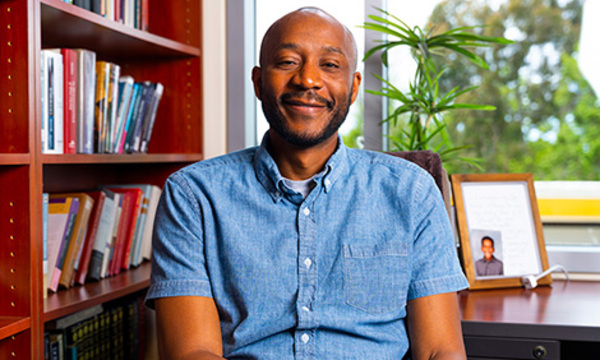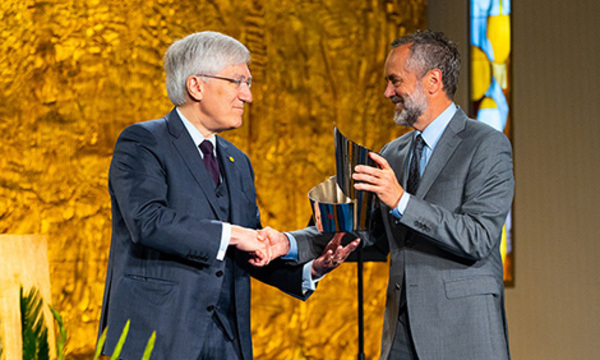When talking about The Fundamentals, it’s important to recognize a distinction from “fundamentalism” as it is understood both in history and in popular culture. The Fundamentals publishing project is a part of the history of fundamentalism in America, to be sure, yet the two words (capital-F Fundamentals and small-f fundamentalism) are also different in important ways. Here’s an overview of how the two are related to and different from one another.
The Fundamentals |
"fundamentalism" |
|---|---|
WHEN |
|
Published in 1910–15 |
Term first coined in 1920 |
| BRIEF DEFINITION | |
A 12-volume series of articles defending the fundamental beliefs of the Christian faith |
“Militantly anti-modernist Protestant evangelicalism”1 |
| HISTORICAL CONTEXT | |
In the first two decades of the 20th century, “conservative and revivalist evangelicals came together in a mutual alliance of self-defense, affirming the traditional historical faith against the powerful forces of modernism. This alliance is perhaps best illustrated in The Fundamentals project.”2 Around the time he founded the Bible Institute of Los Angeles, Lyman Stewart began conceiving of a mass-produced literary project to help stem the tide of modernism, “some kind of warning and testimony to the English-speaking ministers, theological teachers and students, and English-speaking missionaries of the world.”3 This idea would become The Fundamentals. |
“The vast cultural changes of the era from the 1870s to the 1920s created a major crisis within [the] evangelical coalition. Essentially it split in two. On the one hand were theological liberals who, in order to maintain better credibility in the modern age, were willing to modify some central evangelical doctrines, such as the reliability of the Bible or the necessity of salvation only through the atoning sacrifice of Christ. On the other hand were conservatives who continued to believe the traditionally essential evangelical doctrines. By the 1920s a militant wing of conservatives emerged and took the name fundamentalist.”4 |
| DENOMINATIONAL AFFILIATION | |
Wide denominational spread, “from Canadian Anglicans to American Methodists to Princeton Presbyterians to Keswick holiness teachers.”5 |
Initially a broad coalition (conservative Baptists, Presbyterians, Methodists, Episcopalians, Pentecostals, etc.), but by the 1960s, “predominantly Baptist separatists.”6 |
| KEY FIGURES | |
Funders: Lyman and Milton Stewart. Editors: A.C. Dixon, Louis Meyer and R.A. Torrey. Sixty-four authors, including B.B. Warfield, James Orr, G. Campbell Morgan, A.T. Pierson, W.H. Griffith-Thomas, Melvin G. Kyle, Robert Anderson, Thomas Whitelaw and George Frederick Wright. |
Diverse groups evolved over time. Early fundamentalists: R.A. Torrey, A.C. Dixon, William Jennings Bryan, W.J. Riley. Reformed fundamentalists: J. Gresham Machen, Robert Dick Wilson, Francis Schaeffer. Neo-fundamentalists: Charles E. Fuller, Carl F. Henry, Billy Graham. Strict fundamentalists: Bob Jones, Carl McIntire, Jerry Falwell. |
| PRIMARY FOCUS | |
In response to the threats of modernism, theological liberalism and higher criticism’s perceived undermining of the Bible, The Fundamentals sought to build a broad coalition “to testify to the central truths of Christian faith, and to be co-belligerents against liberal theology.”7 The focus was on “a broad defense of the faith”8 which asserted the “historicity and truth of Christian doctrine,”8 including supernatural phenomena such as Christ’s virgin birth, his bodily resurrection and the veracity of biblical miracles.9 |
Baptist journalist Curtis Lee Laws, credited with coining the term “fundamentalism,” defined it as “a protest against that rationalistic interpretation of Christianity which seeks to discredit supernaturalism.”10 In addition to combating “progressivist beliefs that undermined the fundamental doctrines,” fundamentalism also took aim at “progressivist values that undermined the fundamentalist understanding of the Christian life” (such as drinking, dancing, gambling, etc.).11 |
| ON SCRIPTURE | |
All the authors of The Fundamentals were in agreement on the total inerrancy of Scripture. |
The conviction that Scripture is inerrant in every detail is a defining attribute of the fundamentalist movement. |
| LEGACY | |
The Fundamentals became a “symbolic point of reference for identifying a ‘fundamentalist’ movement,” a term that “called to mind the broad united front of the kind of opposition to modernism that characterized [The Fundamentals]. ... They represent the movement at a moderate and transitional stage before it was reshaped and pushed to extremes by the intense heat of controversy.”12 The Fundamentals modeled partnership among conservatives of diverse denominational backgrounds who were willing to work together in spite of their differences to defend the faith against a common enemy (liberalism). “Today we evangelicals take that kind of interdenominational cooperation for granted, just as the notion of ‘mere Christianity’ seems self-evident to us,” notes Biola professor Fred Sanders. “But The Fundamentals was one of the crucial instruments in making those ecumenical connections.” Sanders adds that The Fundamentals offers an encouraging sense of continuity with the past: “Reading something from 100 years ago and mostly agreeing with it is a great experience. Not only does it make us feel justly proud of our founders; it also encourages us that we aren’t just following a script we wrote for ourselves.” Another legacy of the project is how it reinforces the importance of communicating theology in a compelling way: “[The authors] found the sweet spot right between high-end academics and popular proclamation. The whole project was a vast undertaking in Christian education for a very wide audience.” |
The legacy of fundamentalism is ever changing, as are the connotations of the term itself. If The Fundamentals evokes ecumenical partnership for the common good, “fundamentalism” often evokes images of separatism and “culture wars” militancy. If The Fundamentals focused on proactively rearticulating central theological tenets, “fundamentalism” over time took on a more defensive, isolationist posture. The movement emphasized the necessity of purity both in right belief and right behavior (holiness rather than worldliness) and thus became characterized by increasing degrees of separation: first from modernists, then from other churches that didn’t separate enough from modernists, and so on. Fundamentalism has come to mean something sociological as well as theological, bringing to mind biblical inerrancy and dispensationalism but also perceptions of cultural ambivalence, behavioral legalism, anti-intellectualism and hyper-political conservatism. Though still used as a term of self-designation by some, “fundamentalism” has come to be used largely in a disparaging sense as a derogatory label (Alvin Plantinga calls it a “term of abuse or disapprobation”)13 applied broadly to theologically conservative Protestants and in some cases militant conservatives in other faiths (Islam, for example). Because of the term’s baggage, fewer and fewer conservative Protestants self-identify as fundamentalists, typically preferring the term “evangelical.” As Baptist theologian Roger Olson notes, “fundamentalists are evangelicals, but since the 1940s, at least, there are many evangelicals who are not fundamentalists.”14 |
1,8,12. George M. Marsden, Fundamentalism and American Culture 2nd ed. (Oxford: Oxford University Press, 2006).
2,9. Paul W. Rood II, "Remembering The Fundamentals Project: 1909-1915," in vol. 1 of The Spirit of the Fundamentals Project (La Mirada, CA: Biola University, 2014).
3. Letter from Lyman Stewart to C.I. Scofield, dated July 21, 1908.
4,6. George M. Marsden, Understanding Fundamentalism and Evangelicalism (Grand Rapids, Eerdmans, 1991).
5,7. Fred Sanders, "Biola's The Fundamentals Still Relevant Today," Biola Now (February 25, 2013): now.biola.edu
10. Curtis Lee Laws, Herald & Presbyter, July 19, 1922.
11. Justin Taylor, "10 Key Events: Fundamentalism and Evangelicalism in 20th Century America," The Gospel Coalition (April 8, 2014): the gospelcoalition.org.
13. Alvin Plantinga, Warranted Christian Belief (Oxford: Oxford University Press, 1999), 245.
14. Roger E. Olson, "What Distinguishes 'Evangelical' from 'Fundamentalist?'" Patheos (April 19, 2012): www.patheos.com.
 Biola University
Biola University.jpg)

